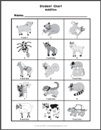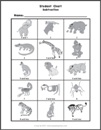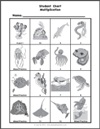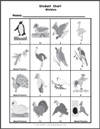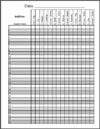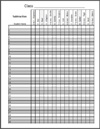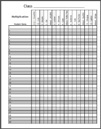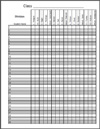
Tools For Math and Science Teachers

Animal Facts
Just Us Fonts & More
1530 Sun City Blvd Suite 120-474
Georgetown, TX 78633
888-511-1201
Contact Us
1530 Sun City Blvd Suite 120-474
Georgetown, TX 78633
888-511-1201
Contact Us
PRODUCTS
OTHER LINKS

Welcome to ANIMAL FACTS!
Animal Facts is a systematic, leveled approach that will help your students acquire their math facts in a positive and fun way. Teachers find it an excellent way to track student progress, and students just LOVE to "capture" the animals. The system allows students to work at their own pace, reducing frustration in both slower and faster learners.
Animal Facts is a systematic, leveled approach that will help your students acquire their math facts in a positive and fun way. Teachers find it an excellent way to track student progress, and students just LOVE to "capture" the animals. The system allows students to work at their own pace, reducing frustration in both slower and faster learners.
It works like this…
Students strive to memorize their math facts through short, timed drills, starting with the most basic. Each set of facts is assigned an animal. When a student exhibits mastery of a set of math facts, they have "captured" the animal!
Once they have captured an animal, they move on to the next set of facts. This process continues until all animals have been captured and the student has mastery of all basic math facts.
A chart is provided for students to track their own progress. Once an animal has been captured, the student can mark the animal by coloring it, x-ing it out, or getting a teacher signature. The teacher also has a chart to track student progress.
Weekly tests are included as an assessment tool. Again, each student would test at their own level.
The Animal Facts system allows children to move at their own pace, and provides all students an opportunity to be successful. This differentiated approach helps prevent slower learners from becoming frustrated, yet still allows more advanced students to proceed at a rapid pace.
Students strive to memorize their math facts through short, timed drills, starting with the most basic. Each set of facts is assigned an animal. When a student exhibits mastery of a set of math facts, they have "captured" the animal!
Once they have captured an animal, they move on to the next set of facts. This process continues until all animals have been captured and the student has mastery of all basic math facts.
A chart is provided for students to track their own progress. Once an animal has been captured, the student can mark the animal by coloring it, x-ing it out, or getting a teacher signature. The teacher also has a chart to track student progress.
Weekly tests are included as an assessment tool. Again, each student would test at their own level.
The Animal Facts system allows children to move at their own pace, and provides all students an opportunity to be successful. This differentiated approach helps prevent slower learners from becoming frustrated, yet still allows more advanced students to proceed at a rapid pace.

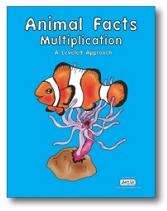
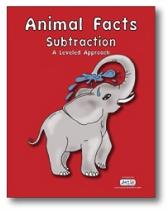
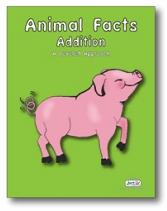
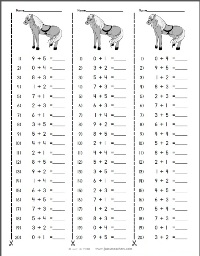
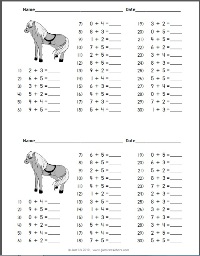
Daily drills can be cut into strips to save paper. There are 3 versions of each daily drill to prevent students from memorizing answers.
There are 2 versions of each test available. Save paper with 2 tests per page.
Each Animal Facts set can be purchased as a PDF download $9.95 each.
Buy a combo and save 10%!
Buy a combo and save 10%!

Updated
7-18-13
7-18-13


FAQs
What facts are covered in each set?
How are the facts arranged to be learned?
How much time do Animal Facts take?
How do I prepare to use Animal Facts?
How do I use the daily drills?
Okay, my students have finished their drills. Now what?
Won't that mean that my students will not all be practicing the same skills?
Do the students correct their drills?
How do the students know which animal they are on?
How should I set up my Animal Facts so that students can get to them easily?
How are the animal tests designed?
How often should students take the tests?
Which test should each student take?
Can students "capture" animals if they score 90% or higher on the test?
What facts are covered in each set?
Addition - adding numbers 0 through 9.
Subtraction- subtracting the numbers 0-9 from 18 and less (the turn-around facts of the addition set).
Multiplication - multiplying the numbers 0 through 12.
Division - dividing the numbers 1-12 from 144 and less (the turn-around facts of the multiplication set).
How are the facts arranged to be learned?
Each fact set starts with what is typically considered the easiest facts and progressively moves through harder fact sets.
After every few fact sets, students have an opportunity to practice all of the facts they learned up to that point.
How much time do Animal Facts take?
Once the students have the routine down, it should only take 2-3 minutes per day.
How do I prepare to use Animal Facts?
1) Run copies of the daily drills and separate them (there are 3 on each page).
2) Place the drills where students can easily access them (create an Animal facts center).
3) Provide each student with a Student Tracking Chart, to be kept in their own notebook or folder.
4) Record each student's name on the Teacher Tracking Chart.
How do I use the daily drills?
This is one suggested routine:
1) Allow students to retrieve the animal they are currently working on (small groups going at once works best).
2) As students return to their seats, they should place their drill face-down on their desks.
3) Once all students have their daily drill, have them:
a. Write their names.
b. Raise their pencils above their heads once their name is written (their pencils, not their hands).
c. Once all students are ready, have them begin the drill. Typically, they have 60 seconds.
d. Provide warnings at 30 seconds and 10 seconds.
e. All students should raise their papers over their heads when the time is up. To prevent cheating, do not accept papers that are not raised in time.
You may want to have early finishers help you pick up the drills.
Okay, my students have finished their drills. Now what?
Check each drill. If you group the drills that are the same animal, it is quite easy to check several at a time. Since the goal is 90% mastery, students cannot miss more than 2 problems. If a student "captured" an animal, record the date on the Teacher Tracking Chart. Return the drills to the students and allow those who have at least 90% mastery to color in their animal on the Student Tracking Chart. That means that when they work on the drills the next day, they should move on to the next animal.
Won't that mean that my students will not all be practicing the same skills?
Exactly! Students progress through the skills at their own pace, allowing those who learn more quickly to move on ahead without having to worry about leaving anyone behind.
Do the students correct their drills?
That is up to the teacher. Practice makes better, so you might wish to have students write their missed facts 3 times each, make flash cards, and/or have them signed by parents.
How do the students know which animal they are on?
They should refer to their Student Tracking Chart. If they lose their chart, you can confirm their animal using the Teacher Tracking Chart.
How should I set up my Animal Facts so that students can get to them easily?
The daily drills and test should be sorted in some way so that students can easily see the animals on each one. Suggest resources are:
1) Place them in trays.
2) Use packet charts.
3) Organize in file folders.
How are the animal tests designed?
Each animal test uses the exact same facts from the same animal's daily drill. Believing that success helps breed success, we have designed the tests so that students actually have more time per problem than on the daily drill. Therefore, a student that is struggling with a particular daily drill can still be moderately successful on the test.
How often should students take the tests?
Once or twice a week. If taken twice a week, we suggest that you take them 2 days in a row and allow students that make 100% the first time to sit out of the second test. Besides motivating students to try their best, knowing that they will have a second chance takes pressure off of students that become anxious when tested.
Which test should each student take?
Students should test on the animal they have most recently been working on during the daily drill. However, it is not recommended that a student test on an animal set that they have not seen before. For example, if they just captured the horse on Thursday, they should go ahead and test on the horse on Friday, not move on to the next set and test on the squirrel.
Can students "capture" animals if they score 90% or higher on the test?
No. Because they are allowed more time per problem on the test, students might be using skills other than recall (counting on fingers, drawing tally marks, etc.) to complete the test. The daily drill is designed to help students best memorize their facts, so it should be the only tool used to allow them to advance through the system.
What facts are covered in each set?
How are the facts arranged to be learned?
How much time do Animal Facts take?
How do I prepare to use Animal Facts?
How do I use the daily drills?
Okay, my students have finished their drills. Now what?
Won't that mean that my students will not all be practicing the same skills?
Do the students correct their drills?
How do the students know which animal they are on?
How should I set up my Animal Facts so that students can get to them easily?
How are the animal tests designed?
How often should students take the tests?
Which test should each student take?
Can students "capture" animals if they score 90% or higher on the test?
What facts are covered in each set?
Addition - adding numbers 0 through 9.
Subtraction- subtracting the numbers 0-9 from 18 and less (the turn-around facts of the addition set).
Multiplication - multiplying the numbers 0 through 12.
Division - dividing the numbers 1-12 from 144 and less (the turn-around facts of the multiplication set).
How are the facts arranged to be learned?
Each fact set starts with what is typically considered the easiest facts and progressively moves through harder fact sets.
After every few fact sets, students have an opportunity to practice all of the facts they learned up to that point.
How much time do Animal Facts take?
Once the students have the routine down, it should only take 2-3 minutes per day.
How do I prepare to use Animal Facts?
1) Run copies of the daily drills and separate them (there are 3 on each page).
2) Place the drills where students can easily access them (create an Animal facts center).
3) Provide each student with a Student Tracking Chart, to be kept in their own notebook or folder.
4) Record each student's name on the Teacher Tracking Chart.
How do I use the daily drills?
This is one suggested routine:
1) Allow students to retrieve the animal they are currently working on (small groups going at once works best).
2) As students return to their seats, they should place their drill face-down on their desks.
3) Once all students have their daily drill, have them:
a. Write their names.
b. Raise their pencils above their heads once their name is written (their pencils, not their hands).
c. Once all students are ready, have them begin the drill. Typically, they have 60 seconds.
d. Provide warnings at 30 seconds and 10 seconds.
e. All students should raise their papers over their heads when the time is up. To prevent cheating, do not accept papers that are not raised in time.
You may want to have early finishers help you pick up the drills.
Okay, my students have finished their drills. Now what?
Check each drill. If you group the drills that are the same animal, it is quite easy to check several at a time. Since the goal is 90% mastery, students cannot miss more than 2 problems. If a student "captured" an animal, record the date on the Teacher Tracking Chart. Return the drills to the students and allow those who have at least 90% mastery to color in their animal on the Student Tracking Chart. That means that when they work on the drills the next day, they should move on to the next animal.
Won't that mean that my students will not all be practicing the same skills?
Exactly! Students progress through the skills at their own pace, allowing those who learn more quickly to move on ahead without having to worry about leaving anyone behind.
Do the students correct their drills?
That is up to the teacher. Practice makes better, so you might wish to have students write their missed facts 3 times each, make flash cards, and/or have them signed by parents.
How do the students know which animal they are on?
They should refer to their Student Tracking Chart. If they lose their chart, you can confirm their animal using the Teacher Tracking Chart.
How should I set up my Animal Facts so that students can get to them easily?
The daily drills and test should be sorted in some way so that students can easily see the animals on each one. Suggest resources are:
1) Place them in trays.
2) Use packet charts.
3) Organize in file folders.
How are the animal tests designed?
Each animal test uses the exact same facts from the same animal's daily drill. Believing that success helps breed success, we have designed the tests so that students actually have more time per problem than on the daily drill. Therefore, a student that is struggling with a particular daily drill can still be moderately successful on the test.
How often should students take the tests?
Once or twice a week. If taken twice a week, we suggest that you take them 2 days in a row and allow students that make 100% the first time to sit out of the second test. Besides motivating students to try their best, knowing that they will have a second chance takes pressure off of students that become anxious when tested.
Which test should each student take?
Students should test on the animal they have most recently been working on during the daily drill. However, it is not recommended that a student test on an animal set that they have not seen before. For example, if they just captured the horse on Thursday, they should go ahead and test on the horse on Friday, not move on to the next set and test on the squirrel.
Can students "capture" animals if they score 90% or higher on the test?
No. Because they are allowed more time per problem on the test, students might be using skills other than recall (counting on fingers, drawing tally marks, etc.) to complete the test. The daily drill is designed to help students best memorize their facts, so it should be the only tool used to allow them to advance through the system.
Addition
Subtraction
Multiplication
Division
Student Charts
Teacher Charts

